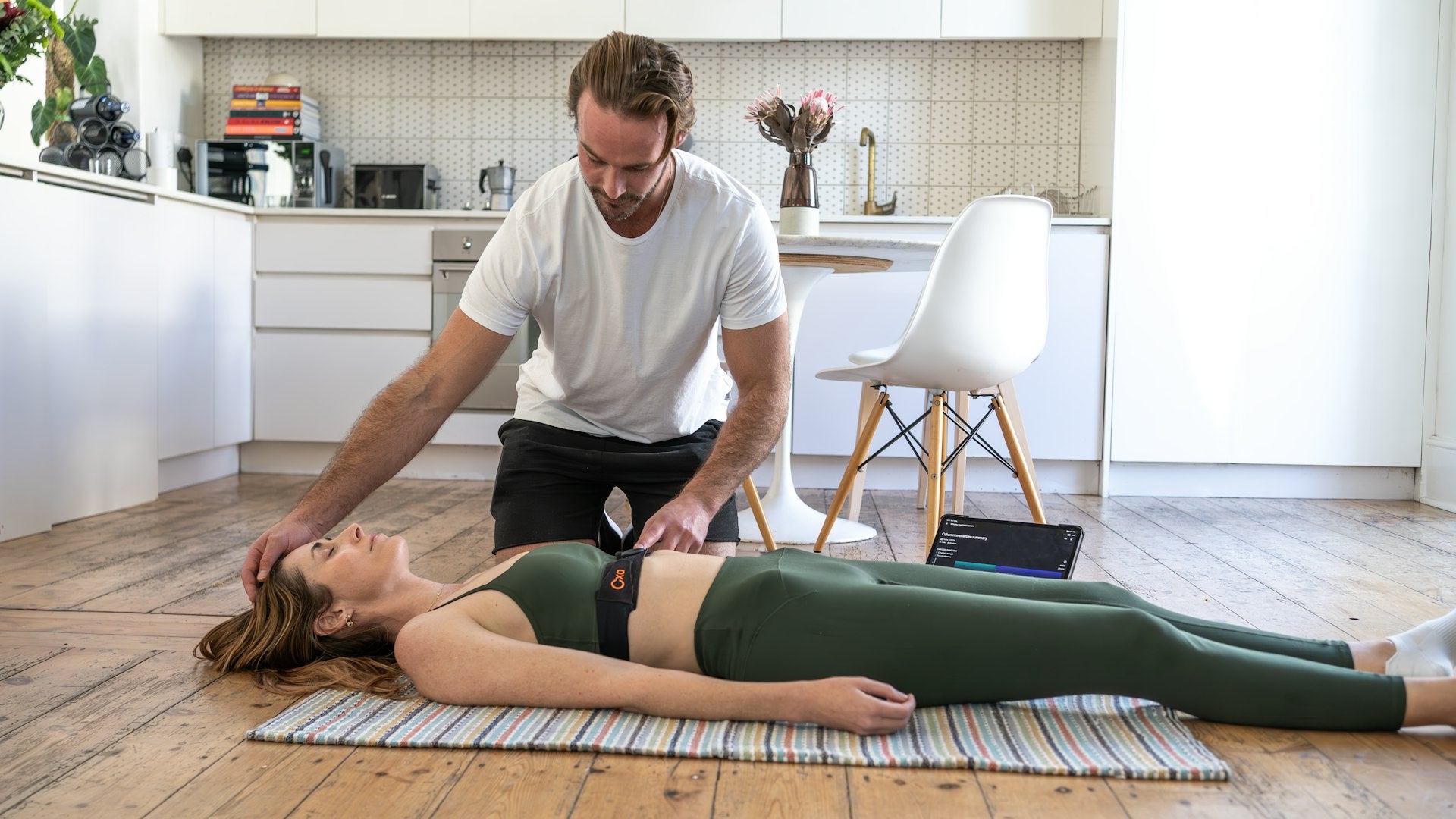Before we start - I prefer not to use the term "breathwork". Why? I don't know - maybe for the same reason that I don't use the word "trance" when I am talking about a hypnotic state. "Breathwork", like "trance", elicits prejudice in some people where they think, "It's just a fad!" or "Yeah, I know all about that...", or "It's just pseudo-science!" - so I prefer to use the term Conscious Breathing. This term emphasises the intentional and mindful aspect of the practice, which aligns with the therapeutic focus on controlling and utilising the breath for specific outcomes.
Conscious breathing and hypnotherapy are two powerful modalities that, when combined, can profoundly impact mental, emotional, and physical well-being. Both techniques have their roots in ancient practices and have been refined through modern science to help you achieve specific goals, whether it be relaxation, reducing anxiety, enhancing creativity, or even overcoming deep-seated fears.
Read on to explore the distinction between hypnotherapy and conscious breathing, how they complement each other, and the various conscious breathing techniques that can be used to shift your mental state. At the end, there are some DIY tips on how to use conscious breathing to achieve different outcomes, from relaxation to improved focus and energy.
Understanding the Difference Between Hypnotherapy and Conscious Breathing
Hypnotherapy
Hypnotherapy is a therapeutic technique that utilises hypnosis to create a state of focused attention, heightened suggestibility, and deep relaxation. During this state, the conscious mind becomes less active, allowing the subconscious mind to become more receptive to positive suggestions and change. Hypnotherapy can be used to address a wide range of issues, including stress, anxiety, addictions, phobias, and even physical conditions like chronic pain.
The key component of hypnotherapy is the hypnotic state (that some people - not me - call it "trance"), which allows me to work directly with your subconscious mind. This state is achieved through various methods, including guided relaxation, visualisation, and positive affirmations. Switch-Up Hypnotherapy sessions start with an interview, and then I help you relax, so that you can access this hypnotic state to help you explore and resolve underlying emotional issues.
Conscious Breathing
Conscious breathing, on the other hand, is a practice that involves the deliberate control of breathing patterns to influence the body and mind. It can be traced back to ancient practices like Pranayama in yoga and Qi Gong in Chinese medicine. Conscious breathing has gained popularity in modern wellness circles due to its ability to induce relaxation, reduce stress, and promote mental clarity.
Unlike hypnotherapy, conscious breathing is often a self-guided practice, though it can also be facilitated by a trained practitioner. The primary goal of conscious breathing is to alter the autonomic nervous system by controlling the breath. This can lead to changes in heart rate, blood pressure, and even brainwave patterns. Different conscious breathing techniques can be used to achieve various outcomes, such as calming the mind, increasing energy, or enhancing creativity.
How Conscious Breathing and Hypnotherapy Complement Each Other
When combined, conscious breathing and hypnotherapy can create a powerful synergy that enhances the effectiveness of both practices. Conscious breathing can help prepare the mind and body for the deep relaxation and focused state needed for hypnotherapy. By calming the nervous system and increasing oxygen flow to the brain, conscious breathing can make it easier for clients to enter a hypnotic trance.
Additionally, incorporating conscious breathing into a hypnotherapy session can deepen the hypnotic state and make the therapeutic process more effective. For example, specific breathing techniques can be used to amplify relaxation, release tension, or even access altered states of consciousness that are conducive to therapeutic change.
What is the science behind Breathwork?
The science behind breathwork, or conscious breathing, revolves around how the way we breathe affects our autonomic nervous system, brain function, and overall physiological state. Modern research has shown that different breathing techniques can have profound effects on mental and physical health, offering benefits ranging from stress reduction to improved cognitive function and emotional regulation.
Key Scientific Principles Behind Conscious Breathing:
1. Autonomic Nervous System Regulation
The autonomic nervous system (ANS) controls involuntary bodily functions such as heart rate, digestion, and respiratory rate. It consists of two main branches:
-
Sympathetic Nervous System (SNS): Responsible for the "fight-or-flight" response, activating during stress or danger, increasing heart rate, and preparing the body for action.
-
Parasympathetic Nervous System (PNS): Responsible for the "rest-and-digest" response, calming the body and promoting relaxation and recovery.
Conscious breathing techniques can influence the balance between the SNS and PNS. For example:
-
Slow, deep breathing: Activates the PNS, reducing heart rate and promoting relaxation. Techniques like diaphragmatic breathing and 4-7-8 breathing stimulate the vagus nerve, which helps to shift the body into a relaxed state.
-
Rapid, forceful breathing: Stimulates the SNS, increasing energy and alertness. Techniques like Breath of Fire are designed to boost energy and sharpen focus by engaging the sympathetic response.
2. Oxygen and Carbon Dioxide Balance
Breathing is the primary way the body regulates oxygen (O2) and carbon dioxide (CO2) levels in the blood. The ratio of O2 and CO2 is crucial for maintaining proper blood pH and ensuring efficient cellular function. Conscious breathing techniques can optimise this balance:
-
Hyperventilation (rapid breathing): Increases O2 levels and decreases CO2, which can lead to temporary changes in consciousness or heightened states of alertness. However, prolonged hyperventilation can cause dizziness or faintness due to the excessive reduction of CO2.
-
Controlled breathing (slow, steady breaths): Helps maintain a stable balance between O2 and CO2, promoting optimal blood pH and ensuring calmness and mental clarity.
3. Neuroplasticity and Brain Function
Research has shown that breath-focused practices can influence brain function and neuroplasticity - the brain's ability to reorganise and form new neural connections. Conscious breathing affects brain regions such as the prefrontal cortex (responsible for decision-making and emotional regulation) and the amygdala (involved in processing fear and stress):
-
Mindful breathing: Enhances activity in the prefrontal cortex, promoting better decision-making and emotional regulation while reducing the reactivity of the amygdala.
-
Breath-focused meditation: Can increase grey matter density in areas of the brain associated with memory, learning, and emotional control.
4. Heart Rate Variability (HRV)
Heart rate variability refers to the variation in time between consecutive heartbeats. Higher HRV is associated with better stress resilience and overall cardiovascular health. Conscious breathing, especially slow and deep techniques, can improve HRV:
-
Coherent breathing (breathing at a consistent rhythm): Synchronises heart rate with breath, promoting a healthy HRV and improving the body's ability to adapt to stress.
5. Hormonal Regulation
Breathing patterns can influence the release of stress hormones like cortisol and adrenaline. By regulating breathing, one can modulate these hormones:
-
Slow breathing: Reduces cortisol levels, leading to a calmer state of mind.
-
Energising breathing (e.g., Breath of Fire): Increases adrenaline, providing a natural energy boost.
6. Impact on Mental Health
Numerous studies have shown that conscious breathing can positively affect mental health by reducing symptoms of anxiety, depression, and PTSD. Techniques that focus on slow, controlled breathing can reduce activity in the sympathetic nervous system, lowering stress levels and improving mood. Additionally, conscious breathing can help individuals feel more grounded and present, which is particularly beneficial for those dealing with anxiety or trauma-related disorders.
7. Altered States of Consciousness
Certain breathing techniques, such as those used in Holotropic Breathwork, can lead to altered states of consciousness. These states may allow individuals to access deeper levels of their psyche, potentially leading to emotional release, spiritual experiences, or new insights. These effects are thought to be related to changes in brainwave activity and the balance of oxygen and carbon dioxide in the body.
Studies Supporting the Benefits of Conscious Breathing:
-
Stress Reduction and Anxiety Management: A study published in Frontiers in Human Neuroscience found that slow-paced breathing exercises, such as diaphragmatic breathing, significantly reduced stress and anxiety levels. The practice was shown to activate the PNS, lower cortisol levels, and improve emotional regulation .
-
Enhanced Cognitive Function: Research from the International Journal of Yoga indicated that pranayama (a form of conscious breathing in yoga) improved cognitive performance, including attention and memory, likely due to increased oxygenation of the brain and the calming effects on the nervous system .
-
Improved Cardiovascular Health: A study in Psychophysiology demonstrated that controlled breathing exercises could improve heart rate variability, which is associated with better cardiovascular health and a reduced risk of heart disease.
-
Mood Improvement and Emotional Regulation: A meta-analysis published in Frontiers in Psychology showed that breath-based meditation techniques, such as mindfulness breathing, were effective in reducing symptoms of depression and enhancing overall well-being .
The science behind conscious breathing highlights its profound impact on the body and mind. By consciously regulating our breath, we can influence the autonomic nervous system, balance oxygen and carbon dioxide levels, enhance brain function, improve heart health, and manage stress and anxiety more effectively. As research continues to unfold, the therapeutic potential of conscious breathing becomes increasingly clear, making it a valuable tool not only in hypnotherapy but also in daily life for improved well-being and mental clarity.
Conscious Breathing Techniques to Change Mental States
Different conscious breathing techniques can be used to shift mental states, each with its own unique benefits. Here are some common techniques and how they can be used in conjunction with hypnotherapy or on their own:
1. Diaphragmatic Breathing (Deep Breathing)
Purpose: Relaxation, reducing anxiety, improving focus.
Diaphragmatic breathing involves breathing deeply into the diaphragm, rather than shallowly into the chest. This type of breathing activates the parasympathetic nervous system, which is responsible for the body’s rest-and-digest response. By slowing down the breath and focusing on deep, abdominal breathing, you can calm the mind and reduce stress.
How to Practice:
-
Sit or lie down in a comfortable position.
-
Place one hand on your chest and the other on your abdomen.
-
Inhale slowly through your nose, allowing your abdomen to rise as you fill your lungs with air.
-
Exhale slowly through your mouth, allowing your abdomen to fall.
-
Repeat for 5-10 minutes.
DIY Tip: Use diaphragmatic breathing before a hypnotherapy session to prepare your mind and body for deep relaxation. It’s also a great technique to use during stressful situations or when you need to calm your mind before sleep.
2. Square Breathing (Box Breathing or 4-4-4-4 Breathing)
Purpose: Reducing stress, improving focus, enhancing mental clarity.
Box breathing, also known as square breathing, involves inhaling, holding the breath, exhaling, and holding the breath again, each for a count of four. This technique helps regulate the breath and bring a sense of calm and control to the mind.
How to Practice:
-
Inhale slowly through your nose for a count of four.
-
Hold your breath for a count of four.
-
Exhale slowly through your mouth for a count of four.
-
Hold your breath again for a count of four.
-
Repeat for 5-10 minutes.
DIY Tip: Use box breathing when you need to quickly calm your mind, such as before a presentation, a difficult conversation, a craving to smoke or vape, or when you’re feeling overwhelmed. It’s also useful during a hypnotherapy session to maintain focus and control.
3. Alternate Nostril Breathing (Nadi Shodhana)
Purpose: Balancing energy, improving mental clarity, reducing anxiety.
Alternate nostril breathing is a technique that involves breathing through one nostril at a time while blocking the other. This practice is said to balance the left and right hemispheres of the brain, promoting mental clarity and reducing stress.
How to Practice:
-
Sit in a comfortable position with your spine straight.
-
Close your right nostril with your right thumb and inhale deeply through your left nostril.
-
Close your left nostril with your right ring finger, release your right nostril, and exhale through your right nostril.
-
Inhale through your right nostril, then close it and exhale through your left nostril.
-
Continue alternating for 5-10 minutes.
DIY Tip: Use alternate nostril breathing when you need to balance your energy and clear your mind. It’s a great technique to practice in the morning to start your day with mental clarity or before a hypnotherapy session to ensure both hemispheres of the brain are engaged.
4. 4-7-8 Breathing
Purpose: Inducing relaxation, reducing anxiety, promoting sleep.
The 4-7-8 breathing technique is a simple but powerful method that helps slow down the nervous system, making it easier to relax and fall asleep. It involves inhaling for a count of four, holding the breath for a count of seven, and exhaling for a count of eight.
How to Practice:
-
Inhale quietly through your nose for a count of four.
-
Hold your breath for a count of seven.
-
Exhale completely through your mouth for a count of eight.
-
Repeat the cycle four times, increasing to eight cycles as needed.
DIY Tip: Use 4-7-8 breathing when you’re feeling anxious, stressed, or having trouble falling asleep. This technique is particularly effective before bedtime or when you need to calm your mind before a hypnotherapy session.
5. Breath of Fire (Kapalabhati)
Purpose: Increasing energy, improving focus, enhancing creativity.
Breath of Fire is a dynamic conscious breathing technique that involves rapid, forceful exhales through the nose while keeping the inhales passive. This technique is often used in yoga to energise the body and mind, clear the respiratory system, and increase mental focus.
How to Practice:
-
Sit in a comfortable position with your spine straight.
-
Take a deep inhale through your nose.
-
Begin to exhale forcefully through your nose, drawing your navel towards your spine with each exhale.
-
Allow the inhales to be passive and automatic.
-
Continue for 1-3 minutes, then take a deep breath and relax.
DIY Tip: Use Breath of Fire when you need a quick energy boost or when you’re feeling mentally sluggish. It’s also a great technique to use before a creative project or brainstorming session.
Common Uses of Conscious Breathing in Everyday Life
Conscious breathing can be used in a variety of situations to enhance well-being and improve mental performance. Here are some common uses:
-
To Relax: Diaphragmatic breathing and 4-7-8 breathing are excellent for calming the mind and body, especially during stressful situations or before bed.
-
To Stop Worrying: Square breathing and alternate nostril breathing can help reduce anxiety and bring a sense of control to the mind.
-
To Think More Clearly: Alternate nostril breathing and Breath of Fire are great for improving mental clarity and focus, making them ideal for work or study.
-
To Be More Creative: Breath of Fire and deep breathing can stimulate the mind and enhance creativity, making it easier to generate new ideas.
-
To Lift Your Energy: Breath of Fire and square breathing can increase energy levels and help you feel more awake and alert.
-
To Stop Feeling Tired: Breath of Fire and deep breathing can help combat fatigue and restore vitality.
-
To Go to Sleep Quickly: 4-7-8 breathing and diaphragmatic breathing are perfect for calming the mind and body, making it easier to fall asleep.
DIY Conscious Breathing Tips for Everyday Use
-
Morning Energy Boost: Start your day with Breath of Fire to energise your body and clear your mind. This technique will help you feel more awake and ready to tackle the day’s challenges.
-
Midday Mental Clarity: If you’re feeling mentally sluggish or unfocused, try alternate nostril breathing to balance your energy and improve concentration.
-
Pre-Bedtime Relaxation: Use 4-7-8 breathing or diaphragmatic breathing to calm your mind and body before bed, helping you fall asleep more easily.
-
Stress Relief on the Go: Whenever you’re feeling stressed or anxious, practice square breathing to quickly calm your mind and regain control.
-
Creativity Booster: Before starting a creative project, try Breath of Fire to stimulate your mind and enhance your creative thinking.
Conscious breathing is a versatile and powerful tool that can be used to enhance the effectiveness of hypnotherapy and improve overall well-being. By understanding the different conscious breathing techniques and how they can be applied, you can take control of your mental and emotional states, whether you’re looking to relax, reduce anxiety, improve focus, or boost creativity.
At Switch-Up Hypnotherapy, we believe in the power of combining conscious breathing with hypnotherapy to achieve lasting change. Whether you’re working with me as your therapist or practising on your own, incorporating these conscious breathing techniques into your daily routine can help you achieve your goals and live a more balanced, fulfilling life.
Ready to unlock the power of your mind AND your body?
Ready to embark on a transformative journey toward the positive change you deserve?
Contact Switch-Up Hypnotherapy today and – Switch-Up your Life!
Make a booking
Luke O'Dwyer







Add comment
Comments